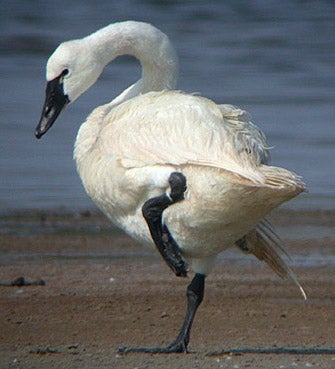SCIENTIFIC NAME:
columbianus
OTHER NAMES:
Whistling swan.
STATUS:
Rare in winter and fall in Tennessee Valley region, but occasional in spring. Occasional in winter and fall in other regions. Low Conservation Concern.
DESCRIPTION:
Tundra swans (Cygnus columbianus) are large birds with a long, extended neck that is equal in length to the body. Adults are white in color (body, neck and wings) with black wing tips. They have black bills with a yellow spot at the base; their legs and feet are also black. Immature birds are brownish gray. At rest, the neck is held straight or with a slight curve near the base. Adult tundra swans average just over four feet in length and weigh about 15 pounds.
DISTRIBUTION:
Tundra swans can be found during the breeding season in the sub arctic and arctic tundra regions of the northwest coast of Alaska, east along the Arctic Circle to Baffin Island, Canada. From these nesting areas, they migrate south along narrow corridors to states west of the Rocky Mountains or to a second major migration corridor that swings across North Dakota, eastward through the Great Lakes states to the Atlantic shore between New Jersey and North Carolina. Most birds winter in the delta marshes of San Francisco Bay on the west coast and Chesapeake Bay in the east.
HABITAT:
Tundra swans are typically found in deltas and marshes from the breeding grounds to the wintering grounds. They also utilize lakes, embayments, and agricultural fields.
FEEDING HABITS:
They feed largely on the leaves, stems and tubers of aquatic and marsh plants; normally in water shallow enough that they only immerse their head and neck as they feed. They have adapted to agricultural fields in some areas, feeding on waste corn and soybeans.
LIFE HISTORY:
Tundra swans usually do not pair or mate before three years of age or later. Arrival and nesting on the breeding grounds is dependent upon spring thawing, but usually occurs from mid-May to the first of June. Nest sites are on hummocks in the marsh or when nesting along the shore, they are generally within 100 yards of the water line. Nests are usually 12 to 18 inches high and composed of moss, grasses and sedges taken from a 15 to 20 foot diameter area around the nest. When located on hummocks, they have been described as looking like a muskrat hut surrounded by a moat. Tundra swans lay four to five eggs that are creamy white in color and acquire a brownish stain over time from the plant material in the nest. Incubation lasts about 31 days. Young swans are called cygnets and usually reach flight stage between 60 and 70 days of age. Survival of a brood of cygnets from hatching to flight stage is 75 to 90 percent. Non breeding swans stay in small flocks of three to 15 during the summer months and gather up with family groups to form pre-migration flocks around 85 days after peak hatching.
REFERENCES:
Bellrose, Frank C. 1976. Ducks, Geese and Swans of North America. Stackpole Books, Harrisburg, PA 543 pp.
Collins, Henry Hill Jr. 1981. Complete Field Guide to North American Wildlife. Harper and Row, Publishers, Inc. New York, NY 714 pp.
AUTHOR:
Mitchell Marks, Wildlife Biologist, Alabama Division of Wildlife and Freshwater Fisheries






